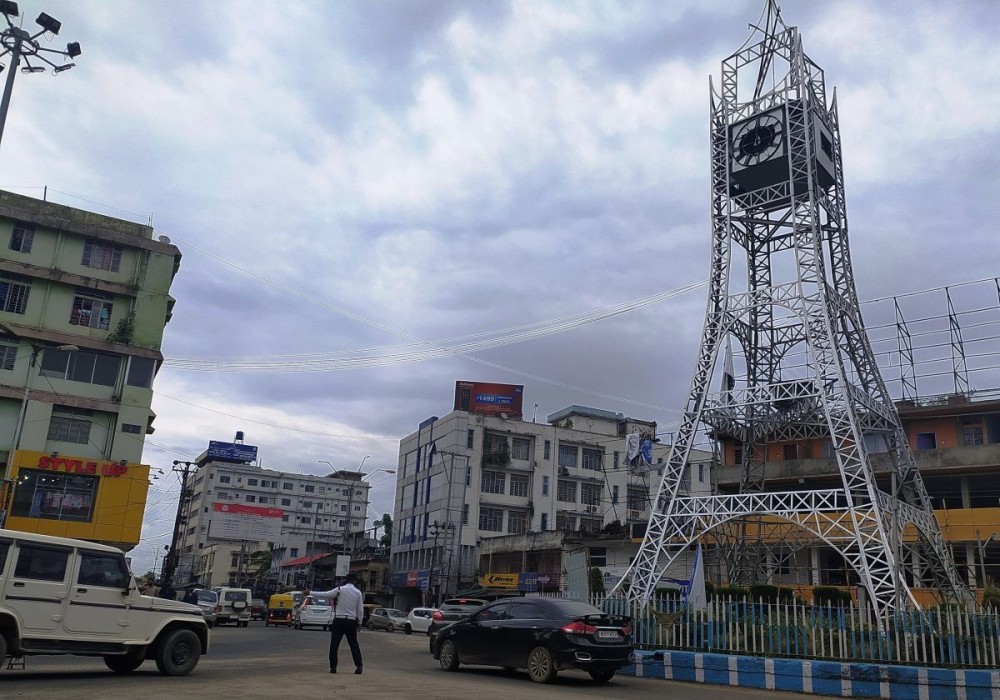A Traffic Police on duty at the City Tower area in Dimapur. (Morung File Photo)

Vikiho Kiba
For more than a decade, Dimapur has stood as Nagaland’s most rapidly developing urban center, a commercial hub where diverse communities converge, trade flourishes, and aspirations rise with each passing year. Yet, beneath this veneer of progress lies an unsettling reality: the steady erosion of public safety and civic confidence. Reports of extortion, kidnapping, harassment, and targeted violence have become disturbingly common, raising an urgent and uncomfortable question. Is Dimapur slipping into lawless chaos?
The perception of rising lawlessness is shaped not only by individual incidents but by a discernible shift in the public psyche. Citizens increasingly speak of fear as a routine emotion rather than an exceptional response to danger. Markets that once bustled late into the evening now close earlier, transport operators drive with heightened caution, and families routinely check on each other’s whereabouts. These behavioural changes suggest a collective acknowledgement that unpredictability has become a defining feature of life in the city.
The proliferation of extortion networks, in particular, has had a corrosive impact on Dimapur’s business environment. For many small and medium enterprises, paying “taxes” to multiple groups has become an unavoidable overhead. Such parallel financial systems distort market dynamics, inflate prices, and disincentivize investment. While these practices have existed for years, their increasing frequency and brazenness indicate a weakening of deterrence. When unlawful levies become normalized to the point of being considered an expected business expense, it signals a deep structural decay in governance.
Kidnappings, whether for ransom, intimidation, or personal vendetta, add another layer of distress to the city’s security landscape. Even in cases where victims are released or recovered, the psychological scars remain. Families grappling with the trauma often describe a loss of faith not only in the perpetrators’ humanity but in society’s collective capacity to protect its members. Such experiences erode trust in institutions and sow doubt about the effectiveness of law enforcement mechanisms.
The role of the police, therefore, is central to the ongoing discourse. It is not enough for authorities to assert vigilance; what the public observes and experiences ultimately shapes perceptions. Instances where complaints go unregistered, cases remain pending without explanation, or investigations stagnate contribute to a widening credibility gap. Even when resource constraints, administrative pressures, or jurisdictional complications are genuine challenges, the absence of visible, proactive engagement can reinforce the impression of institutional inefficacy. In a society where the rule of law is already contested, the perception of an overstretched or indifferent policing system can be as damaging as actual lapses.
However, it would be insufficient and indeed unfair to assign the burden of responsibility solely to the police. Law enforcement agencies operate within a complex socio-political matrix. Dimapur’s unique demographic diversity, its strategic position as a commercial gateway, and the presence of multiple interest groups create conditions that complicate policing efforts. Additionally, factors such as land ownership disputes, unemployment, substance abuse, and informal power structures exacerbate tensions and generate opportunities for criminal behaviour.
A nuanced analysis must therefore recognize that lawlessness does not emerge in a vacuum. It is the product of interconnected failures, economic vulnerabilities, political ambivalence, weakened community cohesion, and inadequate institutional reforms. Addressing these challenges requires a multi-pronged approach: strengthening intelligence networks, modernizing investigative procedures, ensuring transparency in administrative decisions, and enhancing coordination among different enforcement units.
Equally essential is the role of civil society. Community leaders, church organizations, student unions, and neighbourhood bodies historically played a pivotal role in maintaining social order in Nagaland. Revitalizing these institutions can help create a participatory framework where citizens feel empowered to report crimes, resist illegal taxation, and demand accountability from authorities. Public cooperation, when coupled with institutional commitment, can significantly shift the trajectory of security.
Dimapur’s current predicament is not irreversible. Cities across India and beyond have recovered from periods of instability by implementing sustained reforms, investing in community policing, and reinforcing judicial processes. What is required is a collective recognition that normalizing criminal behaviour is neither acceptable nor inevitable. Once a society begins to treat unlawful activities as routine, it loses the very foundation on which democratic order rests.
The question, therefore, is not merely whether Dimapur is slipping into lawless chaos, but whether its citizens, leaders, and institutions are prepared to confront the crisis with seriousness and unity. Restoring public confidence will demand coordinated action, honest introspection, and unwavering political will. Dimapur stands at a critical juncture: the decisions made today will determine whether the city reclaims its promise or continues down a path where fear becomes the default language of everyday life.



